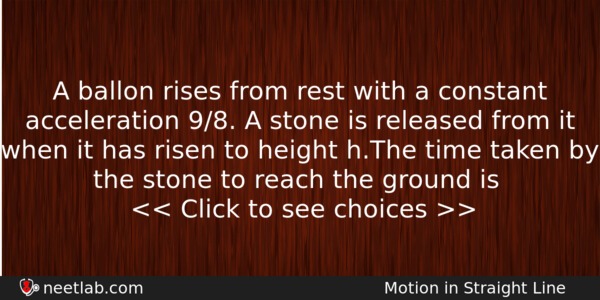| ⇦ | 
| ⇨ |
A ballon rises from rest with a constant acceleration g/8. A stone is released from it when it has risen to height h.The time taken by the stone to reach the ground is
Options
(a) 4√(h/g)
(b) 2√(h/g)
(c) √(2h/g)
(d) √(g/h)
Correct Answer:
2√(h/g)
Explanation:
No explanation available. Be the first to write the explanation for this question by commenting below.
Related Questions: - A small object of uniform density rolls up a curved surface with an initial velocity
- A body of weight W newton is at the surface of the earth.
- 1 a.m.u. is equivalent to
- A person can see clearly objects only when they lie between 50 cm and 400 cm from
- An electric kettle has two heating elements. One brings it to boil in ten minutes
Question Type: A
(1)
Difficulty Level: Medium
(3)
Topics: Motion in Straight Line
(93)
Subject: Physics
(2479)
Important MCQs Based on Medical Entrance Examinations To Improve Your NEET Score
- A small object of uniform density rolls up a curved surface with an initial velocity
- A body of weight W newton is at the surface of the earth.
- 1 a.m.u. is equivalent to
- A person can see clearly objects only when they lie between 50 cm and 400 cm from
- An electric kettle has two heating elements. One brings it to boil in ten minutes
Question Type: A (1)
Difficulty Level: Medium (3)
Topics: Motion in Straight Line (93)
Subject: Physics (2479)
Important MCQs Based on Medical Entrance Examinations To Improve Your NEET Score
18000+ students are using NEETLab to improve their score. What about you?
Solve Previous Year MCQs, Mock Tests, Topicwise Practice Tests, Identify Weak Topics, Formula Flash cards and much more is available in NEETLab Android App to improve your NEET score.
Share this page with your friends

The velocity of the balloon at the height h is
v = √(2ah) = √(2gh/8) = √(gh)/2
Initial velocity of the stone at height h is u = √(gh)/2 upwards
h = ut + gt²/2
put the value of u in the above relation and rearrange the terms to obtain,
(√(gH)/2 )t + gt²/2 – h = 0
(√(gH))t + gt² – 2h = 0
The time taken by the stone to reach the ground can be obtained by solving the above quadratic.
t = 2√[h/g]